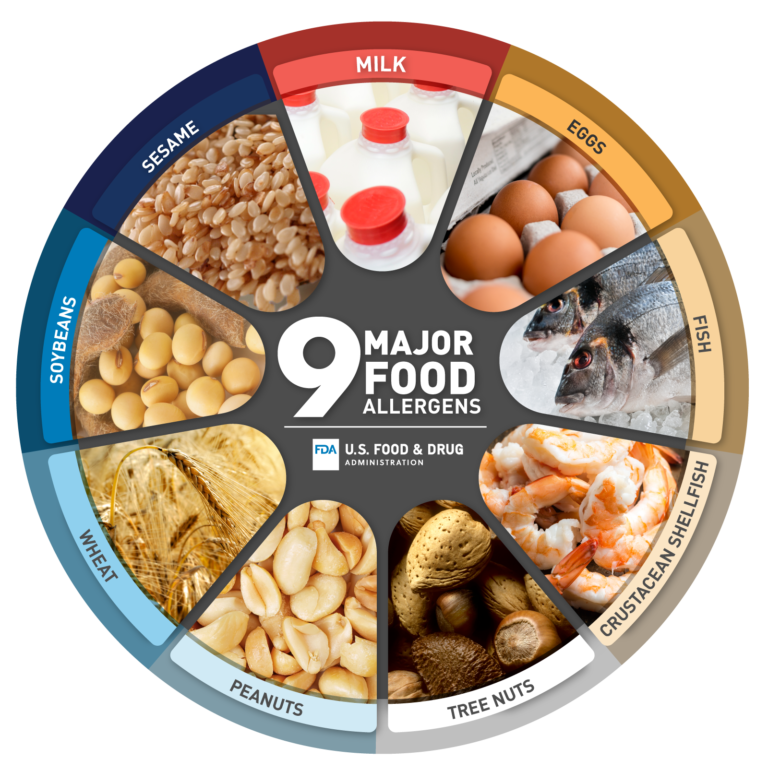Since 2016, FDA has been rolling out (albeit rather slowly), a series of guidance documents for 17 chapters related to FSMA’s Preventive Controls for Human Food Rule (PC Rule). Last week, FDA released two additional chapters on Food Allergen Programs and Acidified Foods. With 10 chapters now available as Draft Guidance, FDA has “only” seven more to complete … but that is a whole different article; this article focuses on some key components of the two draft guidances just released.
We see the allergen guidance as being particularly important given all the consternation that the recent addition of sesame to the major allergen list has caused, especially within the baking industry. Food allergy is one of the most serious food-borne illnesses, so it is appropriate for FDA to take the regulation of allergens very seriously – and this is often reflected in swift and deep enforcement actions when there are allergen concerns.
CHAPTER 11: FOOD ALLERGEN PROGRAM explains how to establish and implement a food allergen program that uses GMPs and preventive controls to minimize or prevent cross-contact and undeclared allergens and ensure proper labeling. It also discusses the use of advisory statements and circumstances in which it, or other such options, may be needed. At 108 pages, it’s impossible to discuss all aspects of the draft guidance in an article, but as a general overview, it discusses:
- What a food allergen program could include, as appropriate to the facility and products, such as the CGMP measures to prevent allergen cross-contact; a hazard analysis that considers these measures; preventive controls to significantly minimize or prevent cross-contact; procedures, processes and practices that include allergen controls; label controls ensuring that the finished food is not misbranded; and a supply-chain program for raw materials and ingredients for which an allergen hazard has been identified as controlled before receipt.
- The guidance includes 20+ pages of examples with detailed recommendations for each aspect of the food allergen program which manufacturers/processors can reference to develop their own food allergen program.
- The guidance also includes a section on allergen advisory statements, stressing that they should not be used in lieu of adherence to CGMPs or other allergen requirements. Any that are used should include a justification from the PCQI in the Food Safety Plan, and verification that any supplier using an allergen advisory statement is not doing so in lieu of adherence to CGMPs or other requirements.
The stress on advisory statements has gained significance with sesame becoming the ninth major food allergen this year. In fact, FDA released a second publication focused primarily on some manufacturers intentionally adding sesame to products that previously did not contain the allergen so as to legally include it on the label. While this does keep manufacturers within the law, it limits options for sesame-allergic consumers, so, while recognizing the related challenges, the FDA is encouraging industry to use the draft guidance and the examples within to significantly minimize or prevent cross-contact rather than intentionally adding sesame to products to comply with the law.
FDA has also published a Draft Compliance Policy Guide on Major Food Allergen Labeling and Cross-Contact, which reflects the agency’s risk-based and science-based approach for the evaluation of potential allergen violations. Of particular interest in this document is FDA’s statement that if an allergen issue is detected, the Agency will undertake a “case-by-case evidence review [that] will include several factors in determining allergen health hazard posed by unintended allergen presence.” The guidance document goes on to lay out the important components of this case-by-case review that all the food industry needs to be familiar with.
CHAPTER 16: ACIDIFIED FOODS details how manufacturers of acidified foods (such as some processed sauces, beans, cucumbers, or cabbage that have an overall pH of 4.6 or below) can use procedures, practices, and processes they established to meet the acidified foods regulations to meet requirements of the PC Rule. At 33 pages, this guidance applies to acidified food manufacturers, processors and packers who are subject to the PC Rule for human foods.
- A primary focus is explaining how procedures, practices, processes, and records put in place for compliance with 21 CFR 108.25 and 21 CFR part 114 can be leveraged to comply, in part, with requirements of the PC Rule’s acidified foods and vice versa. Particularly in relation to hazard analysis, Part 114 includes requirements to control hazards associated with C. botulinum and other critical microorganisms. So, understanding the hazards that can be controlled by complying with part 114 can help one understand which known or reasonably foreseeable (potential) hazards require a preventive control under the PC rule. The guidance also provides some thoughts on simple approaches to complying with both regulations.
- Following this, the guidance primarily applies the requirements of the PC Rule to acidified foods, from PCQI qualifications and oversight to the written food safety plan, preventive controls and their management, and recordkeeping.
- It also notes that Part 114 requires that each container/product be marked with an identifying code permanently visible to the naked eye, a requirement which must be followed even though there is no corresponding requirement in the PC rule.
The proposed guidances are open for comment through the Federal eRulemaking Portal (Docket FDA-2016-D-2343) until February 21, 2024.
TAG would see both chapters as being beneficial to those subject to the related rules. The length, alone, of the allergen draft guidance should provide plenty of information for compliance. And while the acidified document is much shorter, its use of multiple examples should help facilities better understand application to their own processes.
But should you still need assistance with these regulations – or any others from FDA or USDA, give TAG a call. Our experts have decades of experience working with the food industry on regulatory compliance.





